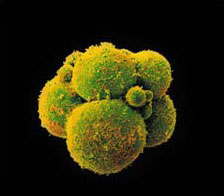
The burgeoning field of biomedical engineering, though still youthful, has shown unusual promise in areas as diverse as vascular replacement and implantable microchips that relay patient medical information. Where humans were once subject to nature’s planned obsolescence, today the fruits of biomedical engineering are used to mend wear, correct dysfunction and improve and extend life. Prosthetic devices routinely replace bones, joints, extremities, ailing internal organs and even skin while skillfully engineered drugs treat illnesses from the common cold to all manner of life-threatening ailments.
Having already transformed our world, biomedical engineering is poised for significant breakthroughs in the coming decades. As Vincent Turitto, director of IIT’s Pritzker Institute of Medical Engineering, explains, “Many people think it will be the engineering discipline of the future due to the rapid growth in our understanding of the biological building blocks, permitting ever more innovative advances by engineers.”
IIT has emerged a leader in this new frontier of engineering and medical technology, conducting pioneering work in pharmaceutical manufacturing procedures, cell and tissue research, medical imaging techniques and neural prostheses. With an ambitious new biomedical initiative, begun in March of last year, IIT plans to significantly broaden the extent of its biomedical endeavors by integrating biomedical engineering and several related disciplines in a new campus complex. Teaching, research and a wide array of entrepreneurial activities will share resources, lab facilities and advanced instrumentation.
Biomedical Research and Development Complex
At the heart of this elaborate undertaking is the new Biomedical Research and Development Complex. Incorporating some 300,000 square feet of existing building space, the extensively renovated and redesigned complex will integrate three existing structures into one all-inclusive setting. Central to the complex is the Engineering Research Building, or ERB. Here IIT will house its much-expanded biomedical engineering program, including teaching and research labs, incubator facilities for launching new biomedical companies and the newly formed Particle Technology and Crystallization Center, or PTCC.
In 1999, IIT launched its doctoral program in biomedical engineering, and this year the first undergraduate students will embark on studies in this intensely interdisciplinary field. Partial funding for the new program has been obtained from the Whitaker Foundation, a private non-profit organization devoted to supporting biomedical engineering research and education. IIT’s program focuses on three areas: cell and tissue engineering-a fast growing area of research, which involves a basic understanding of the chemical and physical factors that influence cell function with the goal of replacing damaged or diseased tissues and organs; neural engineering-groundbreaking research into neural prosthetics to restore visual, hearing and other neurologically related deficits; and medical imaging-research exploring new methodologies to visualize internal body parts and bodily functions in a non-invasive manner.

Through interdisciplinary course work in engineering and related fields- the biological, chemical and physical sciences; chemical and environmental engineering; computer science; electrical and computer engineering; and mechanical, materials and aerospace engineering, IIT will prepare undergraduate students for the challenges they will face in conducting such research. Students will also receive supportive training from the Institute of Psychology and the Center for Ethics in the Professions, as well as from business and law specialists. Such interdisciplinary instruction, a hallmark of IIT’s educational approach, will deepen students’ appreciation of ethical, psychological, business, and regulatory issues related to biomedical engineering.
IIT has already invested some $3 million in the renovation of the ERB, making available 30,000 square feet of space. The bulk of this space consists of hooded and wet laboratory facilities for biomedical and chemical engineering. Grants of $6 million from the State of Illinois will support further design and renovation of the biomedical complex. IIT undergraduate research facilities, comprising laboratories devoted to instrumentation, physiology and transport, as well as a senior projects lab, are included in the proposed ERB laboratory build-out. A graduate lab for instrumentation and neural engineering instruction will likewise be integrated into the new complex. The Chemical Research Building or CRB, contiguous to the ERB, aims to augment the complex with additional space for start-up, graduate and existing companies in the biomedical and chemical engineering fields.
IIT’s Particle Technology and Crystallization Center, also housed in the new complex, is a collaborative effort involving Purdue University, The Massachusetts Institute of Technology, Sanofi-aventis, Bristol Myers Squibb, Abbott Laboratories and other major pharmaceutical companies. PTCC research involves polymorphism the ability of given pharmaceutical compounds to form distinct crystal configurations from the same atoms.
Through integration of the existing Life Sciences division of the IIT Research Institute, or IITRI, the university introduces another core component of its biomedical research complex. Adjacent to the ERB and CRB, the incorporation of IITRI Life Sciences will allow faculty and students to share instrumentation and resources. David McCormick, director of the IITRI Life Sciences division and professor of biology at IIT; Allan Myerson, dean of Armour College of Engineering and Science at IIT; and Vincent Turitto, chairman of IIT’s newly created biomedical engineering department and director of the Pritzker Institute of Medical Engineering, will, together, oversee the integration process.
According to Dean Myerson, “The integration of teaching and research laboratories with instrumentation and R&D facilities, the combined presence of undergraduate and graduate students and faculty, plus incubator facilities to launch entrepreneurial ventures and graduate space for next-stage development and commercialization of new discoveries, will, when pulled together, create a unique synergy.” With the active collaboration of academies and industry beyond the IIT campus, the new initiative will provide fertile ground for learning, discovery and commercialization of cutting-edge biomedical engineering advances.
A significant advantage to IIT’s new Biomedical Complex is its proximity to Argonne National Laboratory. In partnership with IIT, Argonne will provide access to the Advanced Photon Source- a critical research tool used to investigate protein structure, develop new diagnostic procedures, characterize materials and aid in drug discovery. IIT foresees additional collaborative opportunities in teaching, biomedical research and commercial applications with the University of Chicago’s Pritzker School of Medicine and Rush Presbyterian-St. Luke’s Medical Center.
With the university’s elaborate new biomedical engineering facility well underway, IIT takes a step closer to the goals of its biomedical initiative. Illinois Institute of Technology assembles students, faculty and industry participants in one of the 21st century’s most promising domains- an intensely interdisciplinary setting designed to foster creativity and promote new ideas. Participation of additional IIT faculty in diverse disciplines including law, business and psychology, combined with the diverse collaborative involvement of universities, area medical schools and industry, ensure that IIT’s initiative in biomedical engineering will strengthen the institution’s commanding role at the forefront of this stimulating field.
Richard Harth is a science journalist and freelance writer. He lives in New Orleans.